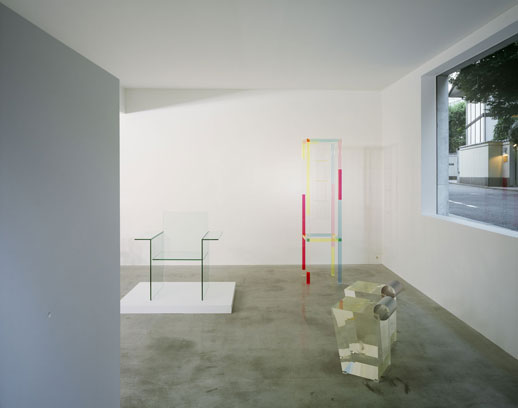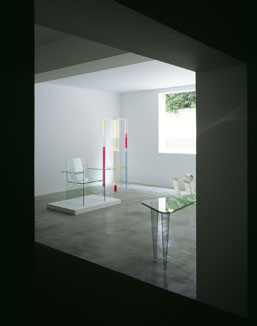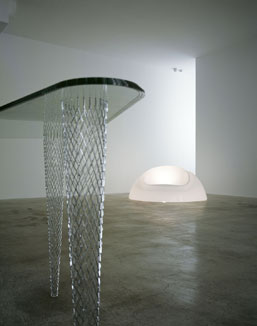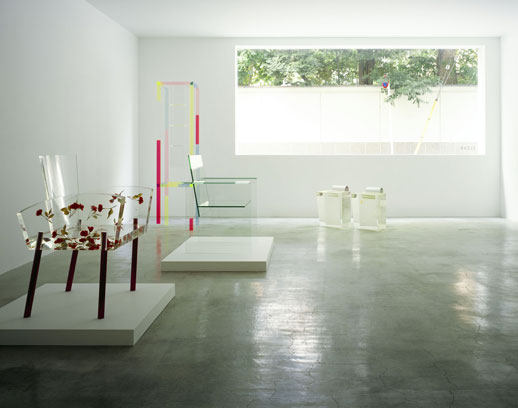Liberated Materials – Clearly Kuramata
Eleven objects, five photos, three books and a pamphlet, all highlights, from the long and diverse career of Shiro Kuramata are currently on exhibit in “Liberated Zone” at Clear Gallery, a venue tucked away on a side street between Omotesando and Shibuya. They have selected objects from his material periods of acrylic, glass and expanded metal (more commonly called mesh or metal grating). Consequently the show emphasizes Kuramata’s obsession with immateriality and transparency.

Kuramata (1934-1991) was a fantastic force in furniture, interior and product design. His works glide effortlessly between the influences of their time, primarily minimalism and post modernism. Rather than being bluntly identified with movements of their time, as is so much design when it focuses on symbols, Kuramata’s fascination with material and poetic detailing simultaneously achieves being of its time and timelessness.
The earliest piece exhibited is Luminous Chair, a white acrylic chair from 1969. Seductively smooth like ice cream carved out with a warm scoop, a hollow for the body has been melted away and a light within the form illuminates with a serene glow. To demonstrate the chair a series of black and white photos shows a backlit naked woman reposing in a variety of positions, mostly womb-like. The photos, looking as dated as the 70s era from whence they come, contain the period’s timeless vitality and conviction that scientific and industrial progress are not at odds with society but in harmony with and accommodating of humanity.


Many of the furniture designs on display developed into environmental works, most often for long-time client Issey Miyake. Glass Chair (1976) preceded Miyake’s showroom by a year in which minimal shelves hung at angles in a type of public gallery. The chair is a poetically marvelous feat; the gallery attendant assured me that it could support about 100 kilograms. A decade later, in 1985, Kuramata designed Twilight Time, a table that combines a stepped-edge glass top with three expanded metal cone-shaped legs. The ensemble looks delicately fragile as if the top were precariously balanced. The transition from glass to expanded metal prefaced his next boutique for Miyake in 1987, which, like the table, had no visible connections or appendages. Both are apparitions in and of space describing form rather than tectonics.

The piece that has captured the creative profession’s fancy and the purse of auction house bidding is Miss Blanche (1988). (In October 2007 Christie’s London auctioned one for a reported £156,500 [35,000,000 yen], three times the estimated upper bid.) The acrylic chair cast with embedded artificial red roses captures the essence of surrealism in furniture—life caught floating frozen timeless in blooming. Kuramata continued with this theme and produced a variety of objects with, most frequently, feathers cast in the resin—a meditation on the paradox of the ephemeral and permanent.
All the works display a refinement, singularity, if not monumentality. However, beyond their slick appearance the work declares optimism in material and industry. The toughest aspect of making things, Kuramata had said, were the seams. They reveal the finite. It was this attention to detail that sets his work apart—never overwrought or highlighted, Kuramata’s details lean toward neat coupling, simple or self-effacing. Clear Gallery’s small but varied collection provides a worthwhile overview of his sensibilities and aesthetics.
James Way
James Way


